When I was trying to find the maximum value of f using NMaximize, mathematica gave me a error saying
NMaximize::cvdiv: Failed to converge to a solution. The function may be unbounded.
However, if I scale f with a large number, say, 10^5, 10^10, even 10^100, NMaximize works well.
In the two images below, the blue one is f, and the red one is f/10^10.
Here come my questions:
Is scaling a general optimization trick?
Any other robust, general workarounds for the optimizations such needle-shape functions?
Because the scaling barely changed the shape of the needle-shape of
f, as shown in the two images, how can scaling work here?
thanks :)
Update1: with f included
Clear["Global`*"]
d = 1/100;
mu0 = 4 Pi 10^-7;
kN = 97/100;
r = 0.0005;
Rr = 0.02;
eta = 1.3;
e = 3*10^8;
s0 = 3/100;
smax = 1/100; ks = smax/s0;
fre = 1; tend = 1; T = 1;
s = s0*ks*Sin[2*Pi*fre*t];
u = D[s, t];
umax = N@First[Maximize[u, t]];
(*i=1;xh=0.1;xRp=4.5`;xLc=8.071428571428573`;
i=1;xh=0.1;xRp=4.5;xLc=8.714285714285715;*)
i = 1; xh = 0.1; xRp = 5.5; xLc = 3.571428571428571`;
(*i=1;xh=0.1`;xRp=5.`;xLc=6.785714285714287`;*)
h = xh/100; Rp = xRp/100; Lc = xLc/100;
Afai = Pi ((Rp + h + d)^2 - (Rp + h)^2);
(*Pi (Rp-Hc)^2== Afai*)
Hc = Rp - Sqrt[Afai/Pi];
(*2Pi(Rp+h/2) L/2==Afai*)
L = (2 Afai)/(\[Pi] (h + 2 Rp));
B = (n mu0 i)/(2 h);
(*tx = -3632B+2065934/10 B^2-1784442/10 B^3+50233/10 B^4+230234/10 \
B^5;*)
tx = 54830.3266978739 (1 - E^(-3.14250266080741 B^2.03187556833859));
n = Floor[(kN Lc Hc)/(Pi r^2)] ;
A = Pi*(Rp^2 - Rr^2);
b = 2*Pi*(Rp + h/2);
(* -------------------------------------------------------- *)
Dp0 = 2*tx/h*L;
Q0 = 0;
Q1 = ((1 - 3 (L tx)/(Dp h) + 4 (L^3 tx^3)/(Dp^3 h^3)) Dp h^3)/(
12 eta L) b;
Q = Piecewise[{{Q1, Dp > Dp0}, {Q0, True}}];
Dp = Abs[dp[t]];
ode = u A - A/e ((s0^2 - s^2)/(2 s0 )) dp'[t] == Q*Sign[dp[t]];
sol = First[
NDSolve[{ode, dp[0] == 0}, dp, {t, 0, tend} ,
MaxSteps -> 10^4(*Infinity*), MaxStepFraction -> 1/30]];
Plot[dp''[t] A /. sol, {t, T/4, 3 T/4}, AspectRatio -> 1,
PlotRange -> All]
Plot[dp''[t] A /10^10 /. sol, {t, T/4, 3 T/4}, AspectRatio -> 1,
PlotRange -> All, PlotStyle -> Red]
f = dp''[t] A /. sol;
NMaximize[{f, T/4 <= t <= 3 T/4}, t]
NMaximize[{f/10^5, T/4 <= t <= 3 T/4}, t]
NMaximize[{f/10^5, T/4 <= t <= 3 T/4}, t]
NMaximize[{f/10^10, T/4 <= t <= 3 T/4}, t]
update2: Here comes my real purpose. Actually, I am trying to make the following 3D region plot. But I found it is very time consuming (more than 3 hours), any ideas to speed up this region plot?
Clear["Global`*"]
d = 1/100;
mu0 = 4 Pi 10^-7;
kN = 97/100;
r = 0.0005;
Rr = 0.02;
eta = 1.3;
e = 3*10^8;
s0 = 3/100;
smax = 1/100; ks = smax/s0;
f = 1; tend = 1/f; T = 1/f;
s = s0*ks*Sin[2*Pi*f*t];
u = D[s, t];
umax = N@First[Maximize[u, t]];
du[i_?NumericQ, xh_?NumericQ, xRp_?NumericQ, xLc_?NumericQ] :=
Module[{Afai, Hc, L, B, tx, n, A, b, Dp0, Q0, Q1, Q, Dp, ode, sol,
sF, uF, width, h, Rp, Lc},
h = xh/100; Rp = xRp/100; Lc = xLc/100;
Afai = Pi ((Rp + h + d)^2 - (Rp + h)^2);
Hc = Rp - Sqrt[Afai/Pi];
L = (2 Afai)/(\[Pi] (h + 2 Rp));
B = (n mu0 i)/(2 h);
tx = 54830.3266978739 (1 - E^(-3.14250266080741 B^2.03187556833859));
n = Floor[(kN Lc Hc)/(Pi r^2)] ;
A = Pi*(Rp^2 - Rr^2);
b = 2*Pi*(Rp + h/2);
Dp0 = 2*tx/h*L;
Q0 = 0;
Q1 = ((1 - 3 (L tx)/(Dp h) + 4 (L^3 tx^3)/(Dp^3 h^3)) Dp h^3)/(
12 eta L) b;
Q = Piecewise[{{Q1, Dp > Dp0}, {Q0, True}}];
Dp = Abs[dp[t]];
ode = u A - A/e ((s0^2 - s^2)/(2 s0 )) dp'[t] == Q*Sign[dp[t]];
sol = First[
NDSolve[{ode, dp[0] == 0}, dp, {t, 0, tend} , MaxSteps -> 10^4,
MaxStepFraction -> 1/30]];
sF = ParametricPlot[{s, dp[t] A /. sol}, {t, 0, tend},
AspectRatio -> 1];
uF = ParametricPlot[{u, dp[t] A /. sol}, {t, 0, tend},
AspectRatio -> 1];
tdu = NMaximize[{dp''[t] A /10^8 /. sol, T/4 <= t <= 3 T/4}, {t,
T/4, 3 T/4}, AccuracyGoal -> 6, PrecisionGoal -> 6];
width = Abs[u /. tdu[[2]]];
{uF, width, B}]
RegionPlot3D[
du[1, h, Rp, Lc][[2]] <= umax/6, {h, 0.1, 0.2}, {Rp, 3, 10}, {Lc, 1,
10}, LabelStyle -> Directive[18]]

